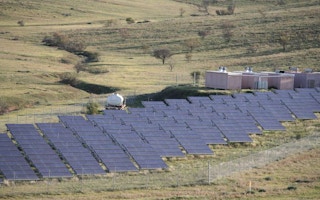This week’s first sitting of the 45th Parliament of Australia is considering a A$6.5 billion “omnibus savings bill”, including a proposed cut of A$1.3 billion to the Australian Renewable Energy Agency (ARENA). If adopted, it would effectively mean the end of ARENA and would devastate clean energy research in Australia.
From driving innovation and economic growth, to creating jobs, to addressing climate change and ensuring a reliable and affordable energy system for the future, ARENA plays a critical role. Most perversely, by reducing Australia’s role in the booming global clean energy industry, closing ARENA would likely reduce Australia’s capacity to balance its budget in years to come.
What is ARENA?
ARENA, an independent Commonwealth agency, has driven most of Australia’s innovative renewable energy projects in recent years. This includes Australia’s world-leading solar photovaltaics research centre at UNSW, the Carnegie wave energy pilot in Perth, AGL’s virtual power station trial and UTS’s own research into local electricity trading and network opportunity mapping.
ARENA has funded 60 completed projects and is managing a further 200. Many more are in the pipeline. It has also leveraged A$1.30 in private-sector R&D funding for every dollar of government funding – a fact that is often overlooked amid talk of budget savings.
Without ARENA’s grants and leveraged co-funding, very few of these projects would have happened. While its sister organisation, the Clean Energy Finance Corporation, plays an important role in helping to finance established renewable projects and technologies, only ARENA can provide the research grant co-funding to develop these technologies in the first place.
ARENA was formed in 2012 as part of the Gillard government’s Clean Energy Future package. It drew together a range of clean energy programs and funds such as the Solar Flagships, the Australian Solar Institute and some, such as the Low Emissions Technology Demonstration Fund, which the Howard government established. ARENA was given the twin goals of:
-
Improving the competitiveness of renewable energy technologies
-
Increasing the supply of renewable energy in Australia.
ARENA was one of five key elements of the Clean Energy Future package slated for abolition by the Abbott government. While the carbon price and Climate Commission were cut, ARENA, the CEFC and the Climate Change Authority were saved by opposition and crossbench support, albeit with a A$435 million cut to ARENA’s original budget.
Now, three years on, the Turnbull government has chosen to keep the CEFC but its plan to slash ARENA’s budget remains. The Labor opposition has yet to announce its position on the proposed cut. Meanwhile, clean energy researchers across Australia have written an open letter calling on all parties to support the agency.
ARENA’s innovation role
The process of energy technology innovation can be thought of as having a series of phases, which have different funding needs (see below).

The innovation chain for renewable energy technologies. Image: ISF, based on ARENA’s Commercial Readiness Index, Author provided
The first phase is typically fundamental research and development. Two examples are the world-leading research programs at UNSW Australia and ANU, which have developed the world’s most efficient solar photovoltaic and solar thermal technologies. Both are ARENA-funded; neither could have been effectively funded by loans.
Technologies then need to be piloted in the real world – as in the case of the Carnegie Wave Energy project in Perth. This stage is often still too risky for most commercial lenders, so some public grant funding remains critical.
Next comes the large-scale demonstration phase – bringing technologies down the cost curve by developing viable business models and supply chains, with the aim of making them cost-competitive. Here, a mix of loan and grant funding is needed.
“
To paraphrase former Harvard University president Derek Bok, if you think research is expensive, try ignorance.
Australia’s large-scale solar industry is an example of a sector in this stage of development. In 2015, ARENA realised that despite having 1.5 million solar roofs and plenty of sunshine, Australia had a dearth of large-scale solar projects (only four operating and four in development). As such, it has committed A$100 million to help build more solar farms.
Finally, there are commercial renewable technologies that are already cost-competitive with other energy sources. Wind energy is the prime example of this, which is precisely why ARENA has not funded wind projects.
Our changing energy system
Innovation is not purely about technology development; it is also about addressing complex challenges such as how to manage the changing nature of our energy system. On a cents per kilowatt-hour basis, wind energy is now cheaper than new-build coal and solar power is cheaper than grid electricity. These two trends will continue, but our energy market is struggling to adapt to the new technology mix.
ARENA has a crucial role to play here. For example, it has funded the Institute of Sustainable Futures (ISF) at UTS to develop a set of Network Opportunity Maps. These show locations in the grid where demand management and decentralised generation (solar, storage etc) can help avoid costly grid upgrades.
ARENA has also funded ISF’s research into local energy trading (also known as peer-to-peer energy or virtual net metering). This is aimed at avoiding the predicted “energy death spiral”, by encouraging consumers and power companies to compromise in making the most of existing infrastructure, reducing consumers’ bills and supporting local power generation.
Meeting our climate targets
Finally, and perhaps most importantly, ARENA is helping to meet Australia’s greenhouse gas emissions target, which calls for a 26-28% cut relative to 2005 levels by 2030.
The electricity sector is Australia’s largest carbon emissions source. ARENA has a vital role in delivering cost-effective emissions reductions. There are two main mechanisms to decarbonise the sector: increasing energy productivity and efficiency, and switching from fossil fuels to renewables. As outlined above, ARENA is a key player in the latter process and is primed to play a leading role in the former.
It would be a tragic error to cut funding to an agency that is making such an important and successful contribution to fulfilling Australia’s obligations under the Paris climate agreement, as well as driving innovation and energy affordability. No other agency combines all of these facets.
More renewable policy instability?
In a 2010 speech on low-carbon energy, Prime Minister Malcolm Turnbull acknowledged the role of government in supporting clean energy innovation, saying:
Government support for innovation and investment in clean stationary energy is important, particularly at the early stages.
The need for this support is not going to go away. If ARENA and its research grant funding is abolished, a similar organisation will doubtless soon need to be re-established. In the meantime, millions of dollars in opportunities would have been wasted and irreplaceable industry and research expertise lost.
After years of policy instability around renewable energy, which has held back the domestic development of one of the world’s fastest-growing industries, do we really want to embrace even more uncertainty?
To paraphrase former Harvard University president Derek Bok, if you think research is expensive, try ignorance.
![]()
Nicky Ison is senior research consultant, Institute for Sustainable Futures, University of Technology Sydney and Chris Dunstan is Research Director, Institute for Sustainable Futures, University of Technology Sydney. This article was originally published on The Conversation.











